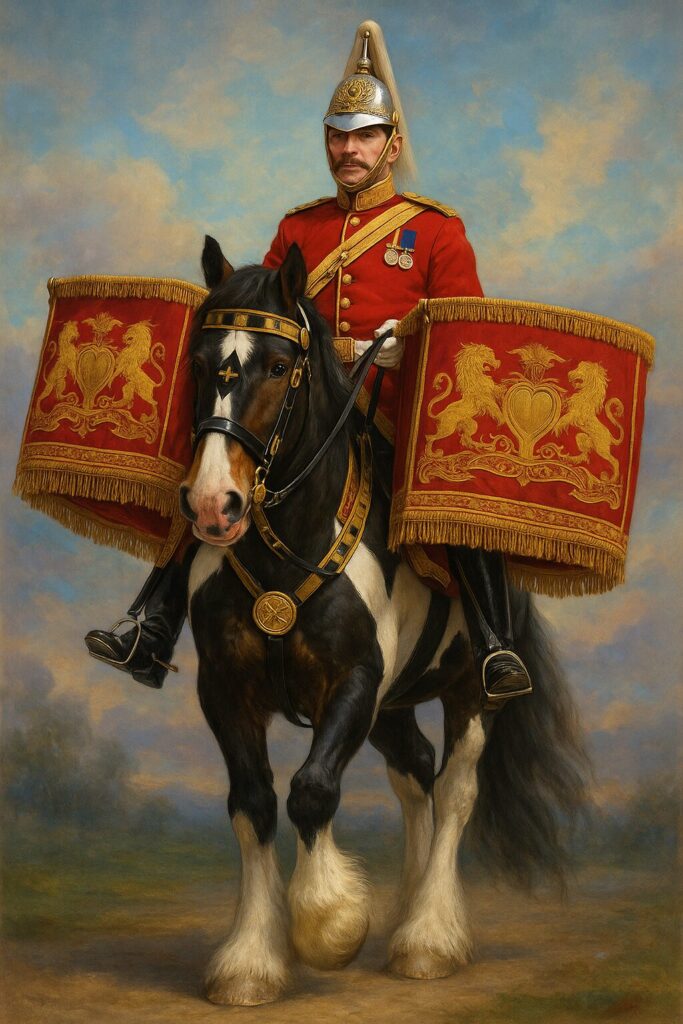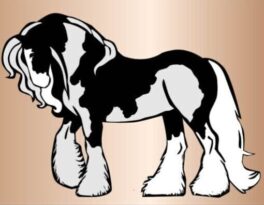The Origins of the Drum Horse
The Drum Horse has a regal history, originally bred for a key role in royal ceremonies within the British monarchy. These powerful and majestic horses carried solid silver kettle drums and a fully outfitted rider as part of Queen Elizabeth II’s Band of the Life Guards. Drum Horses needed extraordinary temperament and discipline, as they had to navigate massive crowds while their riders guided them solely with stirrup-attached reins.
According to All The Queen’s Horses, Queen Elizabeth II initially chose colored Shire horses for this role. However, when the Shire Horse registry stopped recognizing colored Shires, she began looking for alternatives. Her search led to Galway Warrior, a horse who would shape the future of the Drum Horse breed.
Galway Warrior: A Foundational Stallion
Galway Warrior originally went by the name “Beauty” and appeared in the registry under the ownership of Her Majesty the Queen. His sire, Edingale Mascot, was a towering 18.3-hand champion of the National Shire Horse Show. The royal family purchased Mascot for use in formal processions and intended to geld him, but he remained intact. It’s unclear whether he ever bred during his time at Hampton Court Palace.
In 1992, the Windsor Castle fire caused extensive damage and placed a £36.5 million financial burden on the monarchy. Parliament soon required the royal family to begin paying taxes. To help fund the castle’s restoration, the monarchy sold Beauty, who became known as Galway Warrior. An English breeder purchased him and promoted him as a stud stallion.
Jeff Bartko of Black Forest Shire and Gypsy Horses discovered Galway Warrior through the UK magazine Heavy Horse World. Around the same time, Galway Warrior’s son, Chew Mill Guinness, arrived in the U.S. The Zeiglers of Old Mill Farms imported him in 2002. Bred by John and Frances McCormick of Chew Mill Farm in England, Guinness had already competed in Saddleseat classes on both sides of the Atlantic. He also frequently appeared in exhibitions, parades, and other public events while standing as a stallion.
A few months after Guinness’s import, Bartko arranged another shipment—this time focused on Gypsy Vanners. When space ran out, he removed two Vanners from the cargo to make room for Galway Warrior. Once in the U.S., Warrior became the first Drum Horse to appear at BreyerFest in 2003. He captivated audiences and quickly emerged as a foundational figure in the Drum Horse community. He lived out his final years with Jeff and his wife, passing away on July 2, 2009, after leaving a lasting impact on the breed.
The Development of the Drum Horse Breed
Today, the Drum Horse Breed Registry (DHBR) works to grow and promote the breed around the world. We maintain a detailed registry and breed database, support responsible breeding, and raise awareness of the Drum Horse’s unique history and potential. With its origins in royal ceremony and a legacy shaped by horses like Galway Warrior, the Drum Horse continues to impress with its strength, elegance, and versatility.





